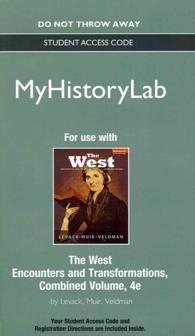- ホーム
- > 洋書
- > 英文書
- > Religion / Ethics
Full Description
Robert J. Rivera critically engages the contemporary challenges of neo-liberal globalization. Concerned with the ways in which neo-liberal processes of globalization can, and do, exclude the most vulnerable, Rivera offers a Christology of liberation that is rooted in, and privileges, the lived realities of the excluded. This Christology is a critical resource that enables the excluded to resist, transform, and re-imagine globalization. In dialogue with the social sciences and decolonial philosophies, Rivera puts forward an account that is suggestive of the ways in which theologians can respond to contemporary challenges of injustice in our world today.
Contents
Acknowledgements
Introduction
a. Statement of the Problem and Thesis.
b. "Toward an International Theological Division of Labor,": Jon Sobrino and Edward Schillebeeckx.
c. Setting and Situation of Jon Sobrino and Edward Schillebeeckx.
d. Outline of the Book.
Chapter One: Globalization and Exclusion
a. Introduction.
b. What Globalization?
c. Whose Exclusion?
d. Theologizing in the Context of Globalization and Exclusion.
e. Conclusion.
Chapter Two: The Christology of Jon Sobrino
a. Introduction.
b. Method in Christology: From the Colonial Christ to Jesus Christ,
Liberator.
c. Jesus and the Kingdom of God: Message, Mission, and Faith.
d. The Death and Resurrection of Jesus.
e. Conclusion.
Chapter Three: The Christology of Edward Schillebeckx
a. Introduction.
b. Situation and Challenge of Christology.
c. Method in Christology: Jesus of Nazareth, Norm and Criterion.
d. The Gospel of Jesus Christ: The Message and Manner of Jesus.
e. The Death and Resurrection of Jesus.
f. Conclusion.
Chapter Four: A Christology of Liberation in an Age of Globalization and Exclusion: Resistance, Transformation, Re-imagination
a. Contributions of Edward Schillebeeckx and Jon Sobrino: Method and Content.
b. Resistance: Challenging the Forces of Neo-liberal Globalization
c. Transformation: A View from the Excluded.
d. Re-Imagination: Another World is Possible, Another World is Present.
e. Conclusion.
Bibliography







